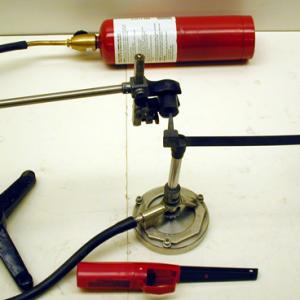College of Liberal Arts & Sciences
5G50.10 - Curie Point of Permanent Magnets
Arrange the magnet and flexible rod so that the magnet just barely holds the rod to it. Heat the junction of the magnet and the rod with the Bunsen burner and observe the loss of magnetic attraction due to heat (Curie Point).
Hang the Monel metal or the nickel coins from the magnet. No need to heat the junction. Just slightly heat the Monel metal and it will fall off the magnet. The coins can also be heated directly but will need a higher temperature to get to the Curie point.
- Chris Chiaverina and George Lisensky, "Nickel Curie Point Engine", TPT, Vol. 52, #4, Apr. 2014, p. 250.
- S. Velasco and F. L. Román, "Determining the Curie Temperature of Iron and Nickel", TPT, Vol. 45, #6, Sept. 2007, p. 387.
- Czesław Kizowski, Sylwia Budzik, and Józef Cebulski, "Finding the Curie Temperature for Ferromagnetic Materials", TPT, Vol. 45, #1, Jan. 2007, p. 31.
- Davod E. Wilson, "Curie Point, Again", TPT, Vol. 27, #5, May 1989, p. 374.
- George Barnes, "Rotary Curie-Point Heat Engine", TPT, Vol. 24, #4, Apr. 1986, p. 204.
- F. A. Levi, E. Bilancia, "Curie Point Experiment", TPT, Vol. 24, #4, Apr. 1986, p. 201.
- George Barnes, "Demonstrating the Curie Point in Nickel", TPT, Vol. 24, #2, Feb. 1986, p. 86.
- Yaakov Kraftmakher, "Spontaneous Magnetization of Ferromagnets", AJP, Vol. 73, #12, Dec. 2005, p. 1191.
- George Barnes, "The Three-Dimensional Hysteresis Surface for Nickel", AJP, Vol. 56, #1, Jan. 1988, p. 45.
- Hans Toftlund, "A Rotary Curie Point Magnetic Engine: A Simple Demonstration of a Carnot-Cycle Device", AJP, Vol. 55, #1, Jan. 1987, p. 48.
- E. V. Smith, "An AC Bridge Method for the Measurement of Curie Points", AJP, Vol. 33, #2, Feb. 1965, p. 167.
- E. V. Smith, "A Neglected Method for Measuring Curie Points", AJP, Vol. 31, #9, Sept. 1963, p. 731.
- William T. Oosterhuis, "Simple Method for Measuring the Curie Point", AJP, Vol. 31, #2, Feb. 1963, p. 132.
- "B-390. Canadian Quarters & Dimes", DICK and RAE Physics Demo Notebook.
- G. D. Freier and F. J. Anderson, "Es-6, 8", A Demonstration Handbook for Physics.
- Wallace A. Hilton, "E-10a", Physics Demonstration Experiments.
- D. Pescetti, "Use of "Monel Metal" in Laboratory Experiments and Lecture Demonstrations on the Ferromagnetic Curie Point", AJP, Apparatus Notes, July 1965-December 1972, p. 91.
- Yaakov Kraftmakher, "7.15, Curie Point", Experiments and Demonstrations in Physics, ISBN 981-256-602-3, p. 483.
- Yaakov Kraftmakher, "5.6, Curie Point", Experiments and Demonstrations in Physics, ISBN 981-256-602-3, p. 331.
- Yaakov Kraftmakher, "3.3, Skin Effect", Experiments and Demonstrations in Physics, ISBN 981-256-602-3, p. 161.
- Arthur B. Ellis, Margret J. Geselbracht, Brian J. Johnson, George C. Lisensky, William R. Robinson, "The Curie Point of Nickel", Teaching General Chemistry - A Materials Science Companion, p. 34.
- "Curie Point", Science Snackbook, 34.1 - 34.2.
- Ron Hipschman, "Curie Point", Exploratorium Cookbook III, 181.1 - 181.4.
- "MONEL Alloy 400", www.specialmetals.com.
-
Rudolf F. Graf, "Heat Destroys Magnetism", Safe and Simple Electrical Experiments, p. 54.
Disclaimer: These demonstrations are provided only for illustrative use by persons affiliated with The University of Iowa and only under the direction of a trained instructor or physicist. The University of Iowa is not responsible for demonstrations performed by those using their own equipment or who choose to use this reference material for their own purpose. The demonstrations included here are within the public domain and can be found in materials contained in libraries, bookstores, and through electronic sources. Performing all or any portion of any of these demonstrations, with or without revisions not depicted here entails inherent risks. These risks include, without limitation, bodily injury (and possibly death), including risks to health that may be temporary or permanent and that may exacerbate a pre-existing medical condition; and property loss or damage. Anyone performing any part of these demonstrations, even with revisions, knowingly and voluntarily assumes all risks associated with them.
